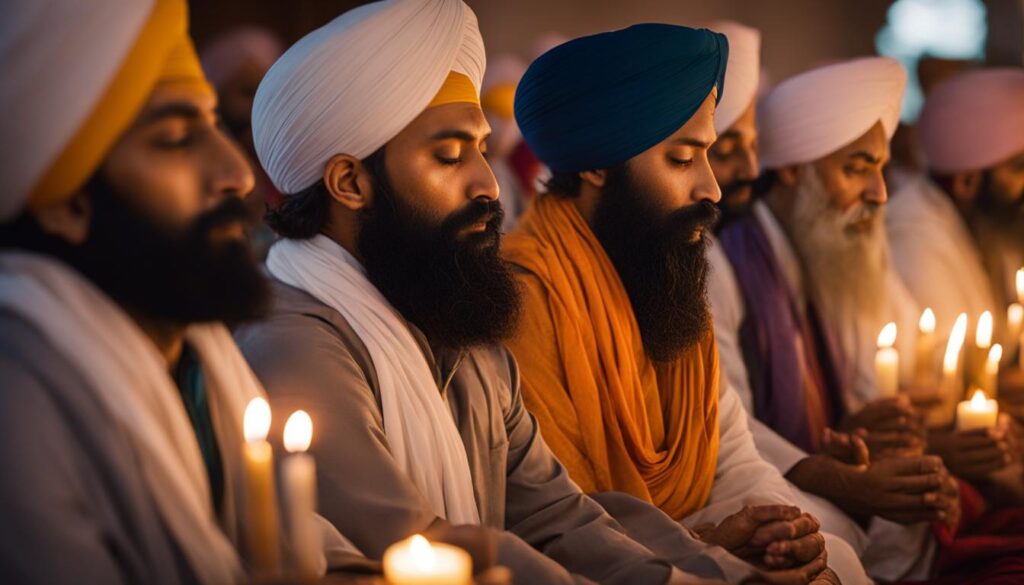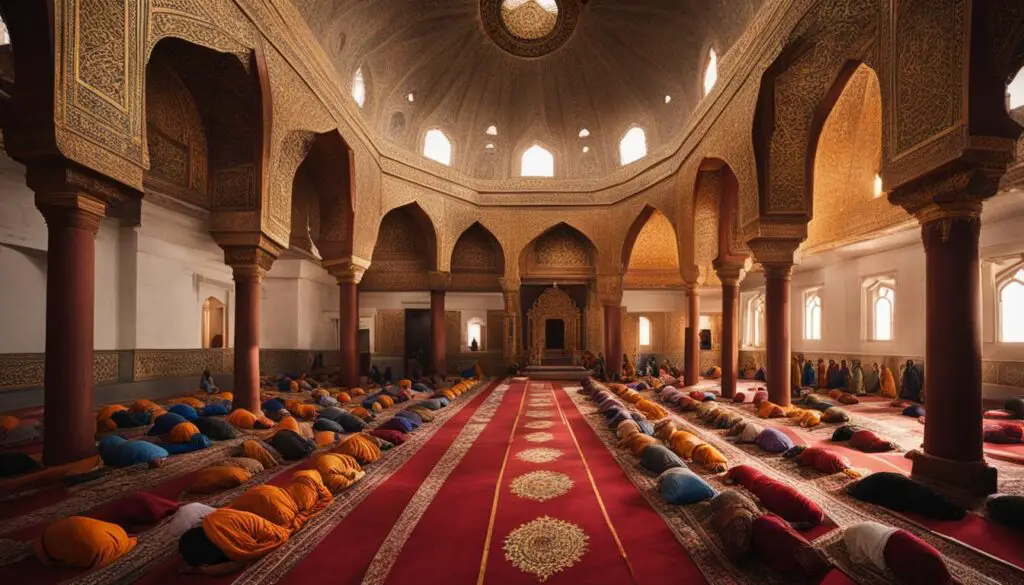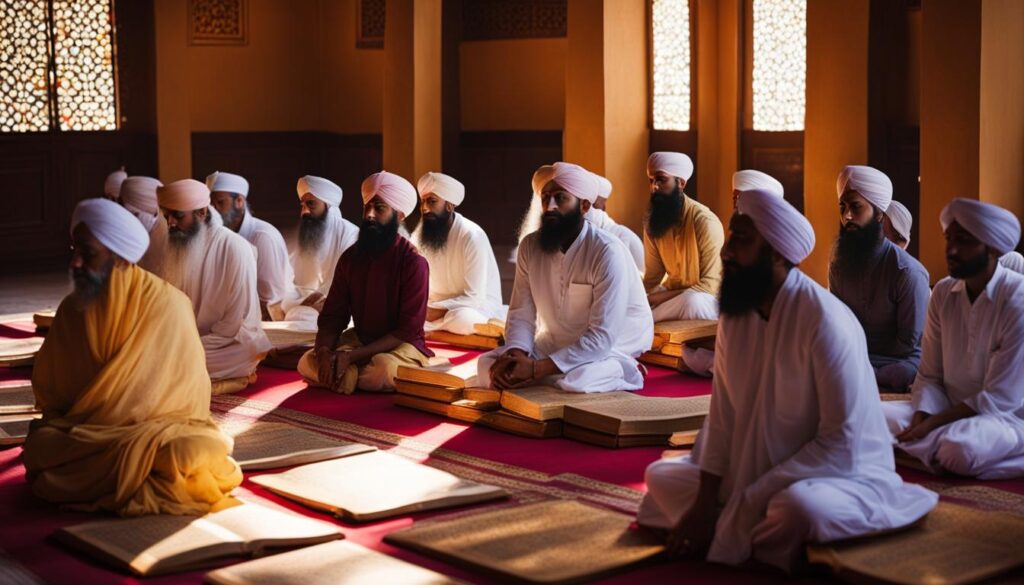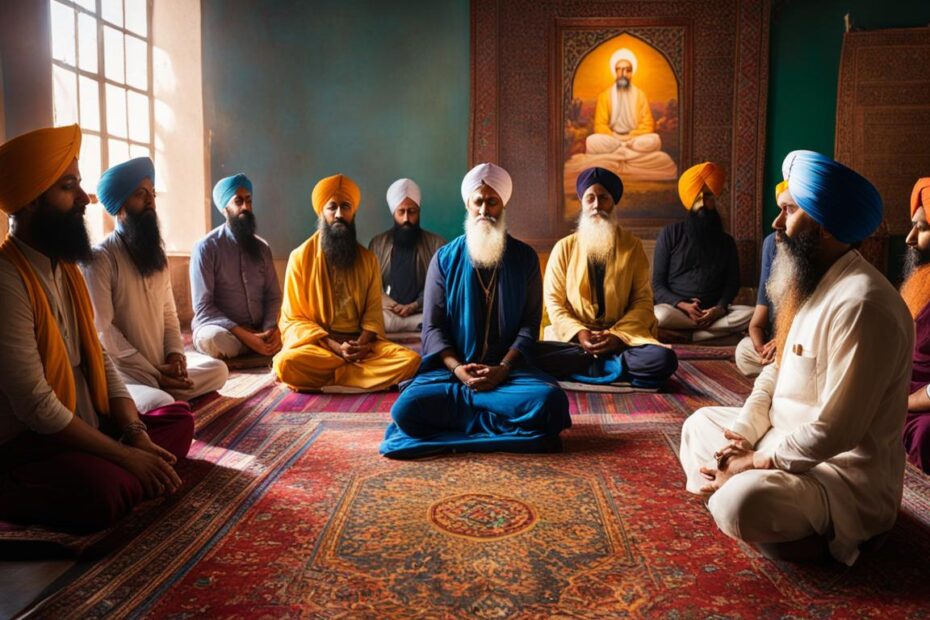Prayer holds a profound significance in Sikhism, as it serves as a means of connecting with the Almighty God in his abstract form. Sikhs worship only one God and show extreme reverence for their prophets, but they do not elevate them to the status of God. The act of bowing to Guru Granth Sahib and other Sikh scriptures is seen as an act of reverence, not worship. Sikhs recite and listen to holy hymns from their scriptures, and individual prayers can be said at any place and time without formalities or rituals. There are specific prayers for morning, evening, and night, each with its own composition and duration. Community prayers are performed in a Sikh temple (Gurdwara), where the sequence of the service includes various hymns, prayers, and the distribution of Kara Prasad (a sweet pudding) and Langar (community meal).
Key Takeaways:
- Prayer in Sikhism is a means of connecting with the Almighty God in his abstract form.
- Sikhs worship only one God and show extreme reverence for their prophets.
- The act of bowing to Guru Granth Sahib and other Sikh scriptures is an act of reverence, not worship.
- Sikhs recite and listen to holy hymns from their scriptures.
- Individual prayers can be said at any place and time without formalities or rituals.
Sikh Prayer Rituals and Practices
Sikh prayers encompass a range of rituals and practices that are an integral part of Sikh spiritual life. These practices are deeply rooted in the Sikh tradition and serve as a means of connecting with the Divine. Sikh prayers are not limited to formalities or rituals but can be said at any place and time. They can be individual prayers or community prayers performed in Sikh temples (Gurdwaras).
Sikh prayers include specific compositions from their scriptures, such as Japji Sahib, Jap Sahib, Sudha Swayas, Rehras Sahib, and Kirtan Sohila. Each prayer holds different compositions and durations, serving different purposes. These prayers are recited and listened to by Sikhs, allowing them to immerse themselves in the teachings and wisdom of their scriptures.
Community prayers in Gurdwaras follow a specific sequence, including the recitation of Asa di var, Anand Sahib, and an Ardas. The Ardas, a vital part of Sikh life, is a prayer of the heart that includes a standard format and allows for the spoken and unspoken prayers of the congregation to flow. Sikh prayer rituals and practices foster devotion, unity, and a deeper spiritual connection with the Divine.
Table: Examples of Sikh Prayers and their Purposes
| Prayer | Purpose |
|---|---|
| Japji Sahib | Reflection and meditation on the qualities of God |
| Rehras Sahib | Evening prayer and reflection on the blessings of the day |
| Kirtan Sohila | Bedtime prayer and seeking protection during the night |
| Anand Sahib | Expressing joy and gratitude for the blessings of life |
| Ardas | Collective prayer seeking blessings and guidance |
Sikh prayer rituals and practices are diverse, reflecting the rich spiritual heritage of the Sikh tradition. They provide Sikhs with a means to connect with the Divine, seek guidance, and express gratitude. Whether through individual or community prayers, Sikhs strive to live a life of devotion, unity, and service to others.
The Significance of Ardas in Sikhism
Ardas, a Sikh prayer, holds immense significance in Sikhism. It is a formula of prayer that includes a specific format and is recited out loud. Ardas can be offered in English or the original Gurmukhi language. It is a collective prayer that incorporates the spoken and unspoken prayers of everyone gathered at a particular moment in time and space.
The Ardas begins with the remembrance of the Sikh Gurus and their contributions, and it offers gratitude and blessings to everyone in the world. This prayer is recited before major events and at the conclusion of Sikh services in the Gurdwara. It serves as a means of invoking specific blessings such as healing and protection. The Ardas is a powerful expression of Sikh devotion and unity.
Through the Ardas, Sikhs express their reverence for the Gurus and seek their guidance and blessings. It is a way to connect with the Divine and invoke its presence in their lives. The Ardas also serves as a platform for Sikhs to offer their prayers and aspirations for individual and collective well-being. It is a powerful tool that allows Sikhs to come together as a community and share their hopes, dreams, and concerns with the Divine.
The significance of Ardas extends beyond its recitation. It is a reminder for Sikhs to remain humble, grateful, and connected to the teachings of the Gurus. The Ardas reinforces the values of selflessness, compassion, and service, which are core principles of Sikhism. It serves as a constant reminder for Sikhs to live their lives in alignment with the teachings of the Gurus and to work towards the betterment of humanity.
Table: Key Elements of Ardas
| Element | Description |
|---|---|
| Remembrance of Sikh Gurus | Prayer begins with honoring the contributions of the Sikh Gurus. |
| Blessings for the World | Prayer extends gratitude and blessings to everyone in the world. |
| Specific Blessings | Ardas invokes specific blessings, such as healing and protection. |
| Shared Prayers | Collective prayer that incorporates the prayers of everyone gathered. |
| Individual and Collective Well-being | Sikhs offer their prayers and aspirations for individual and collective well-being. |
Sikh Prayer Book and Recitation
In Sikhism, the practice of prayer is deeply ingrained in the daily lives of devout Sikhs. One important aspect of Sikh prayer is the recitation of specific prayers from the Sikh prayer book known as Nitnem. Nitnem is a collection of prayers that Sikhs recite daily to maintain a spiritual connection with the Divine.
The Nitnem includes prayers such as Japji Sahib, Rehras Sahib, Kirtan Sohila, and others. These prayers are recited in the Gurmukhi script, the same script used in the Guru Granth Sahib, the central scripture of Sikhism. Each prayer holds deep meaning and significance, offering guidance and inspiration to Sikhs as they navigate their daily lives.
The recitation of Nitnem prayers is considered an essential part of Sikh spirituality. Sikhs often recite these prayers in the early morning hours, setting a positive and focused intention for the day ahead. The practice of reciting Nitnem helps Sikhs stay connected with their beliefs, values, and the teachings of the Sikh Gurus.
| Prayer | Meaning |
|---|---|
| Japji Sahib | A prayer that embodies the core teachings of Sikhism, emphasizing unity, humility, and devotion. |
| Rehras Sahib | A prayer recited in the evening, expressing gratitude for the day and seeking guidance for the night. |
| Kirtan Sohila | A bedtime prayer, offering thanks for the day and seeking protection and blessings for the night. |
By reciting the Nitnem prayers, Sikhs immerse themselves in the wisdom and spirituality of Sikhism, fostering a deeper connection with the Divine and a sense of inner peace and guidance.
The Role of Prayer in Sikh Worship
Prayer plays a crucial role in Sikh worship, serving as a means of connecting with the Almighty God. Sikhs worship only one God, showing extreme reverence for their prophets without elevating them to the status of God. The act of bowing to Guru Granth Sahib and other Sikh scriptures is seen as an act of reverence, not worship. Sikhs engage in both individual and community prayers. Individual prayers can be performed anywhere and anytime, while community prayers are held in Sikh temples (Gurdwaras). These prayer ceremonies in Gurdwaras reflect the devotion, reverence, and gratitude that Sikhs have for the Divine.
Sikhs believe in worshipping only the one Almighty God in his abstract form and do not worship any images, photographs, graves, or objects. Prayer ceremonies in Sikh worship are integral in both individual and community settings, embodying the principles of devotion and unity. The prayers and rituals performed during Sikh worship allow Sikhs to express their desires, seek guidance, and connect with the Divine. It is through these prayers that Sikhs strive to live a life of ecstasy, excellence, and service.

Sikh Worship Ceremonies in the Gurdwara
Prayer ceremonies in Sikh worship take place in Gurdwaras, the Sikh places of worship. Gurdwaras serve as spiritual hubs where Sikhs come together for community prayers, learn about Sikh teachings, and engage in selfless service. Gurdwaras typically have two main halls, one for the placement of Guru Granth Sahib, the central scripture of Sikhism, and another for the community kitchen where Langar, a community meal, is served.
All entrants to a Gurdwara are required to remove their shoes, wash their feet, and cover their heads as a sign of respect. Community prayers in the Gurdwara follow a specific sequence, including various hymns, prayers, and the distribution of Kara Prasad, a sweet pudding, and Langar. The Gurdwara provides a sacred space for Sikhs to come together, fostering devotion, unity, and a deeper connection with the Divine.
| Sikh Worship Ceremonies | Description |
|---|---|
| Individual Prayers | Can be performed anywhere and anytime, allowing Sikhs to connect with the Divine on a personal level. |
| Community Prayers in Gurdwaras | Offered in Sikh temples, these prayers follow a specific sequence, including hymns, prayers, and the distribution of Kara Prasad and Langar. |
| Devotion, Unity, and Service | Prayer ceremonies in Sikh worship foster devotion, unity, and a deeper connection with the Divine, guiding Sikhs to live a life of service and excellence. |
The role of prayer in Sikh worship extends beyond rituals and ceremonies. It is a practice that allows Sikhs to express their love, gratitude, and deepest desires to the Divine. Through prayer, Sikhs seek guidance, healing, and a profound connection with the Almighty God. The power of prayer in Sikh worship fosters devotion, unity, and a sense of purpose in the lives of Sikhs, serving as a means to live in harmony with the teachings of the Sikh Gurus.
The Power of Prayer in Sikhism
In Sikhism, prayer holds immense power. It is considered a direct means of communication with the Divine, allowing Sikhs to seek help, guidance, and healing. The act of prayer is seen as an attitude of exaltation, grace, and kindness that elevates the individual and connects them to the Infinite. Yogi Bhajan, the Sikh spiritual leader, emphasized the power of prayer, stating that it is the most powerful tool for personal and global transformation.
“Prayer is a technology within the human being that allows one to know the unknown, see the unseen, and hear the unheard.” – Yogi Bhajan
Prayer in Sikhism can be both individual and collective. Individual prayers can be said at any place and time without formalities or rituals, allowing Sikhs to connect with the Divine in their own personal way. Community prayers, on the other hand, are performed in Sikh temples called Gurdwaras. When Sikhs come together in prayer, their collective consciousness creates a powerful synergy, amplifying the power of their prayers.
Through prayer, Sikhs tap into the unlimited potential and blessings offered by the Divine. It allows them to align themselves with the Infinite and embody its qualities of love, compassion, and service. Prayer is a means of seeking divine guidance, healing, and protection, enabling Sikhs to live a life of ecstasy, excellence, and service to humanity.
Sikh Meditation Practices: Connecting with the Divine
Sikhism emphasizes the importance of meditation as a powerful practice to establish a deep connection with the Divine. Meditation allows Sikhs to listen to the Infinite within themselves and seek guidance from the Divine presence. It serves as a means to go beyond the individual consciousness and tap into the Universal Consciousness. By quieting the mind and focusing inward, Sikhs aim to access their intuition and receive spiritual insights.
Meditation Techniques in Sikhism
Sikh meditation techniques vary, but they commonly involve focusing on the breath and repeating sacred mantras. One widely practiced technique is Simran, which involves mentally chanting the name of God. Sikhs may also meditate on specific passages from Guru Granth Sahib or utilize visualization practices to foster a deeper sense of connection with the Divine. The ultimate goal of Sikh meditation is to achieve a state of unity with the Divine essence and experience a sense of peace, clarity, and oneness.
Through meditation, Sikhs seek to transcend the limitations of the ego and align themselves with the Infinite. It is a practice that enhances self-awareness, cultivates inner calmness, and nurtures a sense of spiritual growth. Sikh meditation is not limited to a specific time or place and can be practiced by individuals of all backgrounds and walks of life. It is a deeply personal and transformative practice that supports the journey towards spiritual awakening and self-realization in Sikhism.
Table: Comparison of Sikh Meditation Techniques
| Technique | Description |
|---|---|
| Simran | Mentally chanting the name of God to focus the mind and connect with the Divine. |
| Mantra Meditation | Repeating sacred mantras to cultivate a state of inner stillness and spiritual awareness. |
| Gurbani Meditation | Meditating on specific passages from Guru Granth Sahib to deepen the understanding of Sikh teachings and foster a connection with the Divine wisdom. |
| Visualization | Using the power of visualization to create a vivid mental image of the Divine presence, enhancing the sense of connection and unity. |
Sikh meditation practices serve as a powerful tool for spiritual growth and self-transformation. Through the practice of meditation, Sikhs aim to access the depths of their own consciousness and connect with the Divine presence within. It is a personal and introspective journey that helps cultivate inner peace, wisdom, and a deep understanding of Sikh teachings. By incorporating meditation into their spiritual practice, Sikhs seek to attain a state of higher consciousness and embody the virtues of love, compassion, and selfless service.
The Sikh Place of Worship: Gurdwara

The place of worship for Sikhs is called a Gurdwara, which translates to “the doorway to the house of God.” It is a sacred space where Sikhs gather to engage in prayer, learn about Sikh teachings, and engage in selfless service. Gurdwaras serve as spiritual hubs and are an integral part of Sikh religious life.
Gurdwaras typically have two main halls. The first hall is the Darbar Sahib, where the Guru Granth Sahib, the central scripture of Sikhism, is placed on a raised platform called the Palki. This hall is where Sikhs come to bow and show reverence to the Guru Granth Sahib. The second hall is the Langar Hall, where the community kitchen is located. Here, Langar, a community meal, is prepared and served to all visitors and devotees, regardless of their religious or social backgrounds.
When entering a Gurdwara, visitors are required to remove their shoes, wash their feet, and cover their heads as a sign of respect. This practice ensures that the space remains clean and free from impurities. Everyone is welcome at a Gurdwara, and Sikhs believe in promoting inclusivity, equality, and openness to all.
The Five Sikh Takhats: Seats of Authority
Sikhism recognizes five historical Gurdwaras as Sikh Takhats, which serve as thrones vested with the power and authority to regulate the religious life of the Sikh community. These Takhats hold executive, legislative, and judicial powers in matters pertaining to Sikh religious affairs. Each Takhat is associated with a specific Guru and holds deep historical significance within Sikh history.
The five Sikh Takhats are:
- Akal Takhat
- Patna Sahib
- Hazoor Sahib
- Kesgarh Sahib
- Damdama Sahib
These Takhats play a crucial role in maintaining Sikh traditions, resolving religious disputes, and upholding the teachings of the Sikh Gurus. They serve as symbolic seats of authority and unity for the Sikh community, fostering a sense of identity and collective responsibility.
| Takhat | Associated Guru | Location | Significance |
|---|---|---|---|
| Akal Takhat | Guru Hargobind | Amritsar, Punjab | Highest seat of temporal authority of Sikhism |
| Patna Sahib | Guru Gobind Singh | Patna, Bihar | Birthplace of Guru Gobind Singh |
| Hazoor Sahib | Guru Gobind Singh | Nanded, Maharashtra | Location of Guru Gobind Singh’s final days |
| Kesgarh Sahib | Guru Gobind Singh | Anandpur Sahib, Punjab | Foundation of the Khalsa |
| Damdama Sahib | Guru Gobind Singh | Talwandi Sabo, Punjab | Compilation of the Guru Granth Sahib |
These Sikh Takhats are revered as sacred sites by Sikhs and serve as important pilgrimage destinations for Sikhs from around the world.

Sikh Scriptures: Exploring the Wisdom of Guru Granth Sahib
At the heart of Sikhism lies Guru Granth Sahib, the central scripture that embodies the teachings and wisdom of Sikh Gurus. Also known as Adi Granth, it is considered the living Guru and is revered by Sikhs worldwide. Guru Granth Sahib is a collection of hymns and compositions written by the Sikh Gurus, enlightened saints, and contributors from diverse spiritual backgrounds. It offers guidance on leading a righteous and fulfilling life, emphasizing the importance of devotion, selfless service, and the pursuit of spiritual enlightenment.
The reading of Guru Granth Sahib holds immense significance in Sikhism. Sikhs engage in various forms of reading, both in individual and community settings. The Akhand Path, a continuous reading of Guru Granth Sahib, is often organized during important occasions and can take up to 48 hours to complete. The Saptahak Path, which spans over a week, and the Sadharan or Khula Path, a personalized reading by immediate family members, are also common practices. Through the reading of Guru Granth Sahib, Sikhs seek to connect with the divine teachings and find inspiration for their spiritual journey.
| Benefits of Reading Guru Granth Sahib |
|---|
| 1. Spiritual Guidance |
| 2. Insights for Daily Life |
| 3. Connection with the Divine |
| 4. Inspiration for Service |
| 5. Source of Peace and Solace |
The act of reading and meditating on the verses of Guru Granth Sahib is believed to bring numerous benefits to the reader. It provides spiritual guidance, offering insights into the nature of existence, the purpose of life, and the path to salvation. The verses of Guru Granth Sahib also provide practical wisdom for navigating the challenges of daily life, emphasizing virtues such as honesty, compassion, and humility. Through the reading of Guru Granth Sahib, Sikhs aim to establish a deep connection with the divine presence and seek inspiration for selfless service to humanity. The scripture serves as a source of peace and solace, offering comfort and strength in times of difficulty.
Quote:
“The wisdom contained in Guru Granth Sahib is a guiding light for all seekers of truth. It illuminates the path of righteousness, compassion, and self-realization.” – Unknown
For Sikhs, the reading of Guru Granth Sahib is not merely an intellectual exercise but a spiritual practice that nourishes the soul. It is a way to immerse oneself in the divine word and draw inspiration for leading a purposeful and meaningful life. The teachings and wisdom contained within Guru Granth Sahib continue to guide and inspire Sikhs, providing a profound connection to their faith and the eternal truths expressed by the Sikh Gurus.

The Transformative Nature of Prayer in Sikhism
Prayer in Sikhism carries immense transformative power, allowing individuals to connect with the Divine and bring about personal and collective change. Sikhs view prayer as a direct means of communication with the Almighty, a way to express desires, seek guidance, and offer gratitude. Yogi Bhajan, a spiritual leader in the Sikh community, emphasized the transformative nature of prayer, describing it as a technology within the human being that allows one to know the unknown, see the unseen, and hear the unheard.
Through prayer, Sikhs seek to align themselves with the Infinite and embody its qualities. It is believed that prayer opens the door to blessings and grace, enabling individuals to tap into the unlimited potential offered by the Divine. By invoking the power of prayer, Sikhs strive to live a life of ecstasy, excellence, and service.
“Prayer is when you ask God to pray for you. What is God? God is the combination of smell, touch, pain, pleasure, compassion, care, and love. Prayer is when you ask, but you, when you are?” – Yogi Bhajan
The transformative nature of prayer becomes even more powerful when practiced collectively. When Sikhs come together in prayer, their focused collective consciousness creates an exponential effect, amplifying the power of their prayers. The unity and combined energy of the congregation foster a sense of community, strengthen bonds, and generate positive energy and transformation.
Through prayer, Sikhs seek not only personal spiritual growth but also the well-being of the entire world. The transformative power of prayer in Sikhism underscores the profound belief in the interconnectedness of all beings and the potential for positive change through devotion and unity.

The Power of Collective Prayer in Sikhism
Collective prayer holds immense power in Sikhism, bringing together the focused consciousness of a united community to amplify the strength of their prayers. When Sikhs come together in prayer, their collective energy and intention create a powerful force that can bring about positive change and transformation. Yogi Bhajan, a prominent spiritual leader in Sikhism, emphasized the significance of group prayer, stating that the collective prayers of a united community hold more potency than individual prayers alone.
Through collective prayer, Sikhs tap into the unlimited blessings and grace of the Divine. It fosters unity, strengthens bonds, and manifests positive energy that can impact not only individuals but also communities and the world at large. The power of collective prayer is deeply intertwined with Sikh values of selflessness, service, and devotion to the Divine.
“When we pray, God prays for us. This is the fundamental principle: You can’t pray individually, you have to pray in a group. The collective prayer is more powerful than the individual prayer.”
Collective prayer in Sikhism is a sacred practice that enriches the spiritual journey of individuals and promotes communal harmony. It is through the unity of voices, intentions, and hearts that Sikhs experience the transformative power of prayer.
Let us now explore the significance of the Ardas, an essential collective prayer in Sikhism, and how it further exemplifies the power of collective prayer in the Sikh community.
The Ardas: A Powerful Collective Prayer
The Ardas is a vital component of Sikh life and worship. It is a collective prayer that encompasses the spoken and unspoken prayers of everyone present at a particular moment in time and space. The Ardas begins with the remembrance of the Sikh Gurus and their contributions, expressing gratitude and seeking blessings for the entire world. This prayer is recited before significant events and at the conclusion of Sikh services in the Gurdwara.
Through the Ardas, Sikhs invoke specific blessings, such as healing, protection, and guidance. It is a powerful expression of Sikh devotion and unity, bringing together the collective consciousness of the community to connect with the Divine. The Ardas allows Sikhs to align their intentions and prayers, creating a harmonious energy that can bring about positive change and transformation.
| Key Aspects of Collective Prayer in Sikhism | Significance |
|---|---|
| Unity | Collective prayer fosters unity among Sikhs, promoting a sense of togetherness and shared purpose. |
| Strength in numbers | When Sikhs come together in prayer, their collective consciousness creates an exponential effect, amplifying the power of their prayers. |
| Positive energy | Collective prayer generates positive energy that can uplift individuals and communities, fostering a sense of peace, harmony, and well-being. |
| Manifestation of intentions | Through the power of collective prayer, Sikhs can manifest their intentions and seek blessings for themselves and others. |
Conclusion
In conclusion, prayer holds a profound significance in Sikhism, serving as a direct means of connecting with the Almighty God. Sikhs engage in both individual and community prayers, reciting specific hymns and compositions from their scriptures. The Ardas, a vital part of Sikh life, is a collective prayer that invokes specific blessings for the congregation.
Alongside prayer, meditation is another powerful practice in Sikhism, allowing individuals to establish a two-way communication with the Divine. The reading of Guru Granth Sahib, the central scripture of Sikhism, further deepens the spiritual connection and provides guidance in daily life.
Gurdwaras, the Sikh places of worship, play a central role in Sikh religious life, fostering devotion and unity among the Sikh community. Through the power of collective prayer, Sikhs believe in tapping into the unlimited blessings and grace of the Divine.
Ultimately, through prayer, Sikhs seek guidance, healing, and a deeper spiritual connection, striving to live a life of ecstasy, excellence, and service as taught by the Sikh Gurus. Prayer in Sikhism is transformative, bringing about personal and collective change, and strengthening the bonds of the Sikh community.
FAQ
What is the significance of prayer in Sikhism?
Prayer holds a profound significance in Sikhism as a means of connecting with the Almighty God in his abstract form and seeking guidance, healing, and a deeper spiritual connection.
What are the different Sikh prayer rituals and practices?
Sikh prayer rituals and practices include reciting specific prayers from the scriptures, engaging in community prayers in Gurdwaras, and performing Ardas, a collective prayer that invokes specific blessings.
What is the importance of Ardas in Sikhism?
Ardas is a vital part of Sikh life and serves as a collective prayer that invokes specific blessings. It is recited before major events and at the conclusion of Sikh services in Gurdwaras.
What is the Sikh prayer book and how is it recited?
The Sikh prayer book, known as Nitnem, contains a collection of prayers that are recited daily. The prayers, such as Japji Sahib, Rehras Sahib, and Kirtan Sohila, are recited in the Gurmukhi script.
How does prayer play a role in Sikh worship?
Prayer is an integral part of Sikh worship, both in individual and community settings. Sikhs engage in individual prayers anywhere and anytime, while community prayers are held in Gurdwaras and follow a specific sequence.
What is the power of prayer in Sikhism?
Prayer in Sikhism is considered transformative, allowing individuals to seek help, guidance, and healing from the Divine. Through prayer, Sikhs tap into the unlimited potential and blessings offered by the Almighty.
What is the practice of meditation in Sikhism?
Meditation is another powerful practice in Sikhism, allowing individuals to establish a two-way communication with the Divine. It complements the practice of prayer and helps seekers connect with their inner selves.
What is a Gurdwara and what role does it play in Sikh religious life?
A Gurdwara is a Sikh place of worship where Sikhs gather for community prayers, learn about Sikh teachings, and engage in selfless service. It serves as a spiritual hub fostering devotion and unity.
What are the Sikh Takhats and their significance?
The Sikh Takhats are five historical Sikh Gurdwaras that hold executive, legislative, and judicial powers regarding Sikh religious affairs. They play a crucial role in maintaining Sikh traditions and upholding the teachings of the Sikh Gurus.
How is Guru Granth Sahib read in Sikhism?
Guru Granth Sahib, the central scripture of Sikhism, is read through various formats such as the continuous reading (Akhand Path), weekly reading (Saptahak Path), and personalized reading (Sadharan or Khula Path).
What is the transformative nature of prayer in Sikhism?
Prayer in Sikhism is considered transformative, capable of bringing about personal and collective change. Through prayer, Sikhs align themselves with the Infinite, seek blessings, and strive to live a life of ecstasy, excellence, and service.
What is the power of collective prayer in Sikhism?
Collective prayer holds immense power in Sikhism, with the focused collective consciousness of a united community amplifying the potency of prayers. The collective prayers of a united community are believed to tap into the unlimited blessings and grace of the Divine.








